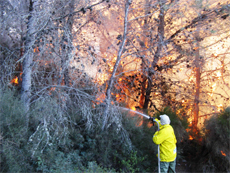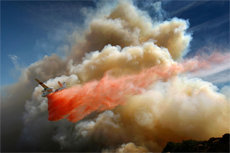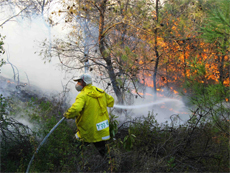JNF FORESTER IN WPG: THE POLICY OF ISRAEL’S NATIONAL PARKS AUTHORITY TO NOT THIN THE FORESTS MAY HAVE TO CHANGE By Rhonda Spivak, January 19, 2011 Kalil Adar, Director of the Forest Department of the Northern Region of the Jewish National Fund, who actively battled against the largest fire in Israeli history, which claimed 44 lives, visited the Jewish community here prior to Tu’Bishvat. In speaking about the tragedy of the Carmel, Adar noted that the State of Israel was under-prepared for such an event and in short, “We were caught with our pants down as we had never encountered a fire in such scale.” However, he added, “ With all the odds against us we succeeded in controlling the fire, with international aid, but especially thanks to our courageous fire fighters and intrepid belief that there is no another Carmel and we have to stop the fire from spreading.” Adar noted “that KKL-JNF fire fighters fought bravely”, and said that the equipment (such as ‘new fire trucks, hoses, and vests etc’) that was donated by Jewish communities around the world to the KKL-JNF was “important and critical”, in overcoming the fire. Adar noted that “only 10% of the forests destroyed were JNF-KKL managed forests. The other 90% were in land that was part of the National Parks Authority, which is considered protected land. Their policy was not to open new roads, or maintain old roads or thin the forest. We in JNF-KKL treat out forests, thin them, and maintain our road system. But their policy up until now has been don’t touch them.[the forests]” In those parks and reserves the lack of routes through the forests made it more difficult for firefighters to douse the flames and the failure to thin the forests meant that there was high amounts of accumulated fuel. “We may now bring in more black goats to graze in the mature forests and this will thin them out,” said Adar. He noting that in the days of the Ottoman Empire there were no natural forests by virtue of all the grazing that had occurred by numerous black goats. ) He added that natural forests in the area did exist as evidenced by the fact that “the pollen of plants contained signs of both oak and pine.’ In addition to the use of “black goats” other measures Adar suggested could be taken are “controlled” or “prescribed fires,” in small scales and silvicultural practices mimicking natural disturbance (e.g. thinning, pruning etc’): ( Note: A controlled fire is a fire set by foresters which is a measure taken in the United States, for example, to thin a forest ) Adar explained that controlled burns are not popular and practical in Israel, as are in the U.S, because the lack of a social license. “In our protected open lands fire is and always was a distractive force that we have to eliminate and fight against. Nevertheless, prescribed fires should not be dismissed totally from our toolbox as foresters.” Israel, according to Adar, is very fragmented and forests “are all near villages” and it’s “not that simple to create and maintain fuel breaks. Although, for many years now KKL-JNF has invested money, knowledge and manpower in creating fuel breaks around villages with high fire risks.” He added “People don’t like trees being cut down. People don’t like seeing smoke and fire so we haven’t done this….But maybe by law we will have to have the fire brigade come to a village and say you have to cut this tree down. Things have to change now.” Adar also estimated that without international aid the fire, which burned about 30,000 dunams would have lasted “another few days, covering an additional stretch of green forests, until there was rainfall. He also spoke of how important Mt. Carmel is to the people of Israel, and how although small is size compared with North American fires, this fire was a “national trauma.” Adar also told the Winnipeg Jewish Review in an interview that he “knew of at least 20 fires set which police suspect were acts of arson,” immediately following the outbreak of the massive fire raging in the Carmel last month. Adar said “I do not think these were fires set by Jews.” He further noted that as in the past, arson or environmental terror, is a means by which some extremist Arab Israelis act out against Israel. “The forest is a symbol of the State, of the government, or a flag” and arson terror is something that has occurred before and continues, Adar noted. “The arson was reported by some in the Israeli media but not in such a big way,” said Adar, who was stationed in Nir Etzion “in the south west” area covered by the fire. [ i.e. YNET reported that Israeli police sources estimated that arsonists were taking advantage of the situation in the north and were attempting to distract forces dealing with the massive fire by producing additional emergency events. [ see http://www.ynetnews.com/articles/0,7340,L-3993916,00.html ) http://www.israelbehindthenews.com/bin/content.cgi?ID=4228&q=1.] Adar, who lives in Abirim says also that “some have criticized the JNF-KKL for planting pine trees.” But, he rejected that criticism saying that “ Aleppo pine (Pinus halepensis) was always a natural species to Israel. Mount Carmel and the area that burned ‘has the biggest and oldest population of natural pine trees in the country.” The pines, like the oak trees, burned in this fire. Adar, said, however, “Both have accustomed to fire and could regenerate easily after it. The pines need extreme temperatures to spread their seeds, and therefore are called seeders, while the broadleaf species will sprout after fire.” He added, “A few days after the fire we saw their seeds on the ground. Some of them won’t find the right habitats or will be eaten by ants and rodents…But still the future pine forest is likely to succeed in natural regeneration.” When asked what the JNF will be doing to rehabilitate its forests, Adar responded, “We will open new trails for safety, and planting will be in very small portions only. We want to maintain the unique plant community of the Carmel. We won’t introduce new species. We’ll wait a while to see if there is natural regeneration. If there’s not we may plant tree species to increase forest diversity and sustainability.” Adar said that the JNF-KKL believes that there “should be a collaboration with the Israel Parks Authority to restore and rehabilitate the burned area. KKL has the knowledge and experience of how to restore burned areas and how to manage afforested lands.” Adar also spoke of the heroic people, for example, in Beit Oren, who fought valiantly to save their houses. “What saved people’s life and homes was that they refused to leave and let go… It didn’t bother or interfere with the fire fighters at all, the contrary, it helped a lot and made the whole difference.” Adar rejected the claim that Shas Minister of Interior Eli Yishai, was to blame for the inadequate state of the equipment and preparedness of the State to confront this fire. “He is not to blame. It is a series of people before him, not just him. They are all responsible. This has been neglected for years.” Adar said that now he believed that the relevant authorities would have to make it a priority to boost Israel’s firefighting capabilities. |
||
JNFspokesman: “We knew of at least 20 fires set which police suspect were acts of arson,” Wave of arson occured after the outbreak of the initial fire













